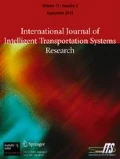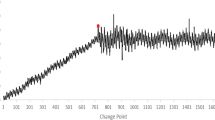Abstract
This paper develops a framework to test Bottom-up segmentation and Wavelet transform capability to distinguish on-peak from off-peak periods given the time series of the travel time. The proposed techniques are tested on the times series of travel time obtained from 15 working days of Bluetooth data on Brisbane’s busiest urban corridor. This study shows that the peak period can be systematically determined from either Bottom-up segmentation or WT on the time series of travel times. The Bottom-up segmentation technique estimated a mean peak period over the 15 working days of 106 min, compared to 99 min with Wavelet transformation. Further investigation is warranted should a recommendation be made as to which technique can more reliably estimate peak period.









Similar content being viewed by others
References
Brisbane City Council: Greater Brisbane Key Corridors Performance July–December 2017. Queensland Department of Transport and Main Roads (2018)
Alfa, A. S and Chen, M., “Timing plans for a signalized intersection during the peak period”, Engineering optimization, 15(2), Taylor & Francis Group, 1989. pp. 153–162, doi:https://doi.org/10.1080/03052158908941149
Hellinga, B., Abdy, Z.: Signalized intersection analysis and design: implications of day-to-day variability in peak-hour volumes on delay. J. Transp. Eng. 134(7), 307–318 (2008). https://doi.org/10.1061/(ASCE)0733-947X(2008)134:7(307)
Arnott, R., De Palma, A., Lindsey, R.: A structural model of peak-period congestion: a traffic bottleneck with elastic demand. Am. Econ. Rev. 83(1), 161–179 (1993)
Hu, R., Chen, L., Zheng, L.: Congestion pricing and environmental cost at Guangzhou Baiyun international airport. J. Air Transp. Manag. 70, 126–132 (2018). https://doi.org/10.1016/j.jairtraman.2018.04.016
Alfa, A.S., Chen, M.: Temporal distribution of public transport demand during the peak period. Eur. J. Oper. Res. 83(1), 137–153 (1995). https://doi.org/10.1016/0377-2217(93)E0311-K
Jara-Díaz, S., Fielbaum, A., Gschwender, A.: Optimal fleet size, frequencies and vehicle capacities considering peak and off-peak periods in public transport. Transp. Res. A. 106, 65–74 (2017). https://doi.org/10.1016/j.tra.2017.09.005
Cole-Hunter, T.A.: Effects of Air Pollution Exposure on Adult Bicycle Commuters: an Investigation of Respiratory Health, Motorised Traffic Proximity and the Utility of Commute Re-Routing. Queensland University of Technology (2012)
Bolland, J and Ashmore, D.: Traffic Peak Spreading in Congested Urban Environments”, 25th Australasian Transport Research Forum, 2–4 October. Canberra. (2002)
Holyoak, N and Chang, Y. M.: Peak spreading behaviour and model development”, 29th Australasian Transport Research Forum (ATRF) Proceedings, 29. (2006)
Bhaskar, A., Qu, M., Chung, E.: Hybrid model for motorway travel time estimation considering increased detector spacing. TRR. 2442, 71–84 (2014)
Bhaskar, A., Tsubota, T., Kieu, L.M., Chung, E.: Urban traffic state estimation: fusing point and zone based data. TRR. 48, 120–142 (2014)
Respati, S. W., Bhaskar, A., Zheng, Z and Chung, E.: Systematic Identification of Peak Traffic Period”, 2017.. Australasian Transport Research Forum 2017 Proceedings
Brisbane City Council,:Key Corridors Performance Report January – June 2015”, pp.5. 2015. Queensland Department of Transport and Main Roads
Nantes, A., Ngoduy, D., Bhaskar, A., Miska, M., Chung, E.: Real-time traffic state estimation in urban corridors from heterogeneous data. TRR. 66, 99–118 (2016)
Abedi, N., Bhaskar, A., Chung, E.: Tracking spatio temporal movement of human in terms of space utilization using media access control address data. Appl. Geogr. 51, 72–81 (2014)
Abedi, N., Bhaskar, A., Chung, E., Miska, M.: Assessment of antenna characteristic effects on pedestrian and cyclists travel-time estimation based on Bluetooth and WiFi MAC addresses. TRR. 60, 124–141 (2015)
Tsubota, T., Bhaskar, A., Chung, E.: Macroscopic fundamental diagram for Brisbane, Australia: empirical findings on network partitioning and incident detection. TRR. 2241(1), 12–21 (2014). https://doi.org/10.3141/2421-02
Kieu, L.M., Bhaskar, A., Chung, E.: Empirical modelling of the relationship between bus and car speeds on signalised urban networks. Transp. Plan. Technol. 38(4), 465–482 (2015). https://doi.org/10.1080/03081060.2015.1026104
Michau, G., Nantes, A., Bhaskar, A., Chung, E.: Bluetooth data in urban context: retrieving vehicle trajectories. IEEE Trans. Intell. Transp. Syst. 18(9), 2377–2386 (2017. (In Press). https://doi.org/10.1109/TITS.2016.2642304
Michau, G., Pustelnik, N., Borgnat, P., Bhaskar, A., Chung, E.: A primal-dual algorithm for link dependent origin destination matrix estimation. IEEE. 3(1), 104–113 (2017). https://doi.org/10.1109/TSIPN.2016.2623094
Bhaskar, A., Chung, E.: Fundamental understanding on the use of Bluetooth scanner as a complementary transport data. TRR. 37, 42–72 (2013)
Bhaskar, A, Kieu, L. M. K., Qu, Minh, Nantes, A, Miska, M and Chung, E, “Is bus overrepresented in Bluetooth MAC Scanner data? Is MAC-ID really unique? “,Int. J. Intell. Transp. Syst. Res., 13(2), 2015 .pp. 119–130
Keogh, E., Chu, S., Hart, D., Pazzani, M.: Segmenting time series: A survey and novel approach. Data mining in time series databases. 57, 1–22 (2004). https://doi.org/10.1142/9789812565402_0001
Samant, A., Adeli, H.: Feature extraction for traffic incident detection using wavelet transform and linear discriminant analysis. CACIE. 15(4), 241–250 (2003). https://doi.org/10.1111/0885-9507.00188
Zheng, Z., Ahn, S., Chen, D., Laval, J.: Freeway traffic oscillations: microscopic analysis of formations and propagations using wavelet. Transp. Res. B Methodol. 45(9), 1378–1388 (2011). https://doi.org/10.1016/j.trb.2011.05.012
Zheng, Z., Ahn, S., Chen, D., Laval, J.: Applications of wavelet transform for analysis of freeway traffic: bottlenecks, transient traffic, and traffic oscillations. Transp. Res. B Methodol. 45(2), 372–384 (2011). https://doi.org/10.1016/j.trb.2010.08.002
Xie, Y., Zhang, Y., Ye, Z.: Short-term traffic volume forecasting using Kalman filter with discrete wavelet decomposition. Computer-Aided Civil Infrastructure Engineering. 22(5), 326–334 (2007). https://doi.org/10.1111/j.1467-8667.2007.00489.x
“Wavelets 4 Dummies: Signal Processing, Fourier Transforms and Heisenberg”. Available at: https://georgemdallas.wordpress.com/2014/05/14/wavelets-4-dummies-signal-processing-fourier-transforms-and-heisenberg/ (accessed 15 Sept 2018)
Zheng, Z., Washington, S.: On selecting an optimal wavelet for detecting singularities in traffic and vehicular data. Transp. Res. C. 25(C), 18–33 (2012). https://doi.org/10.1016/j.trc.2012.03.006
Department of Transport and Main Roads: Queensland Transport and Roads Investment Program 2017-18 to 2020-21 Queensland Transport and Roads Investment Program (QTRIP), (2017)
Acknowledgements
The authors would like to thank the Brisbane City Council for providing the Bluetooth data used for this research.
Author information
Authors and Affiliations
Corresponding author
Additional information
Publisher’s Note
Springer Nature remains neutral with regard to jurisdictional claims in published maps and institutional affiliations.
Rights and permissions
About this article
Cite this article
Connors, P., Respati, S., Sharma, A. et al. Systematic Traffic Peak Period Identification Using Bottom-Up Segmentation and Wavelet Transformation. Int. J. ITS Res. 18, 256–266 (2020). https://doi.org/10.1007/s13177-019-00196-z
Received:
Accepted:
Published:
Issue Date:
DOI: https://doi.org/10.1007/s13177-019-00196-z




